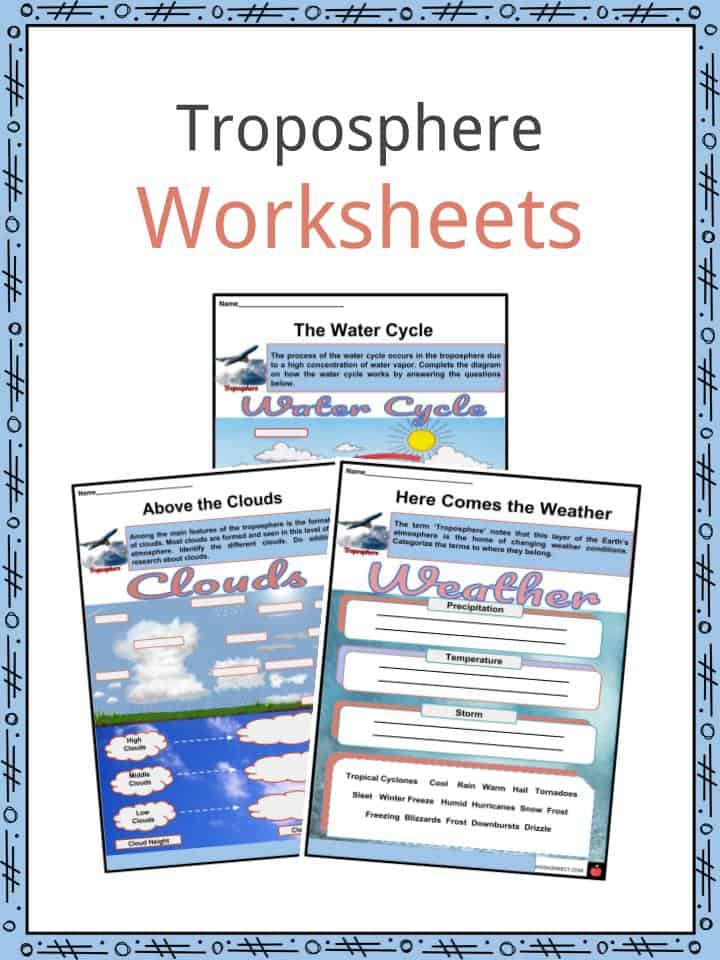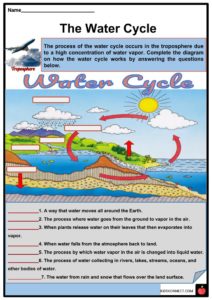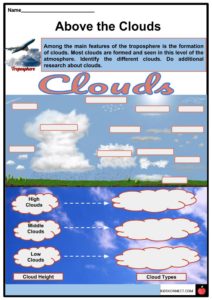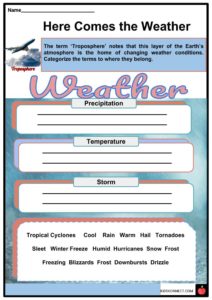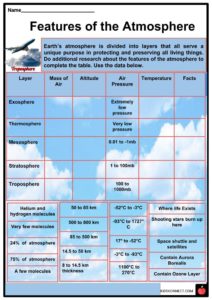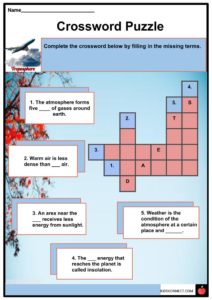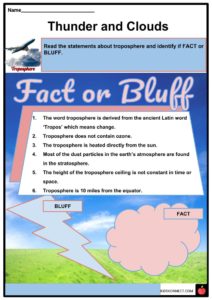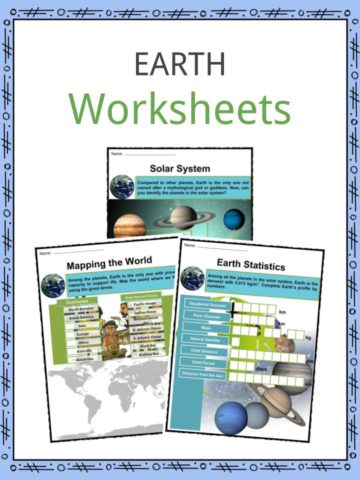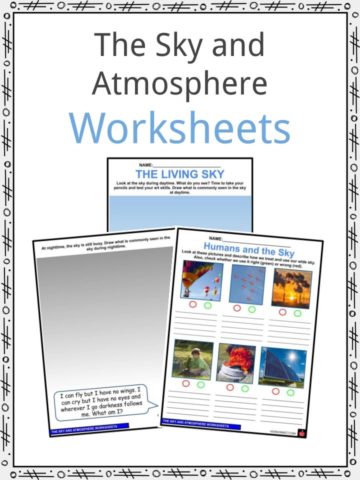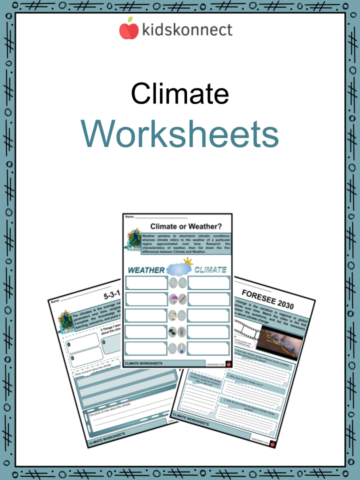Download This Sample
This sample is exclusively for KidsKonnect members!
To download this worksheet, click the button below to signup for free (it only takes a minute) and you'll be brought right back to this page to start the download!
Sign Me Up
Table of Contents
The troposphere is the bottom layer of the Earth‘s atmosphere, measuring an average of 13 kilometers over the planetary surface and containing the majority of meteorological occurrences. It makes up three-quarters of the entire mass of the atmosphere and contains 99% of the total weight of moisture and aerosols.
See the fact file below for more information on the troposphere or alternatively, you can download our 25-page Troposphere worksheet pack to utilize within the classroom or home environment.
Key Facts & Information
Troposphere
- It got its name from the Greek words “tropos” and “sphaira,” which mean “spinning” and “sphere,” respectively. This is the structure and phenomenon of rotating turbulence, which mixes the layers of air.
- The planetary boundary layer (PBL) was generated by rotational friction against the Earth’s surface, which also impacts airflow. PBL ranges in height from hundreds of meters to two kilometers depending on latitude, landform, and time of day when measured.
- Its temperature remains constant due to the tropopause, its boundary layer with the stratosphere, and an inversion layer that causes air temperature to rise with altitude.
- Weather phenomena, including wind, rain, and snow, happen in this atmospheric layer. When the sun heats the ground, hot air rises. From this point on, the water evaporates and rises with the hot air to cooler altitudes. Clouds form because the chilly air cannot capture all of the water. When the Tropopause is reached, the water and air stop rising and create rain, snow, or hail.
- The troposphere has the highest oxygen and water vapor concentrations, making biosphere life conceivable, and is where all living things can develop. It regulates the temperature of the Earth, and the heat contrasts between day and night would make life impossible without the troposphere. This is a crucial quality for all living things. The sun’s rays penetrate through the troposphere and become “trapped,” causing the earth’s temperature to increase to habitable levels.
- It is in this stratum that airplanes fly. Because of the shortage of oxygen and the cold at the height of the flight, they must pressurize their cabins. The troposphere is the lightest layer of the atmosphere, but it also contains the most turbulence.
Structure
Composition
- It is humidified via evaporation, which produces atmospheric water vapor from bodies of water, and transpiration, which occurs owing to vegetation on the surface. These processes have an impact on the occurrence of meteorological events.
- Its temperature drops at high altitudes due to invasion layers in the tropopause. Low air temperature lowers the saturation vapor pressure at higher altitudes.
Pressure
- Its maximum air pressure, or atmospheric weight, is at sea level.
- At high altitudes, the hydrostatic equilibrium, a state in which air pressure balances to the weight of air above a given point on the planetary surface, causes its maximum air pressure to fall.
Temperature
- It is heated by latent heat, thermal radiation, and sensible heat from the Earth’s surface. Meanwhile, because its layers of gases are less dense at the geographic poles and denser at the equator, its surplus heating and vertical expansion occur in tropical latitudes.
- At the tropopause, the temperature drops from 15°C to -55°C on average in the middle latitudes and from 20°C to -75°C at the equator.
- As altitude increases, its temperature decreases.
- The Environmental Lapse Rate (ELR) is a measure of the rate of decrease in air temperature represented as the numeric difference between the surface temperature and the tropopause, which is then divided by altitude.
- The ELR is computed under the assumption that the atmosphere is static, with no mixing of the layers of air. The ELR equation also assumes that heated air expands and rises as it becomes buoyant.
- The varying temperature is caused primarily by the planetary surface absorbing different amounts of solar energy, which heats the troposphere as it radiates outwards.
Compression and Expansion
- Because of the reduced atmospheric pressure at high elevations, a parcel of air rises and expands. The air parcel’s expansion pushes outwardly against the surrounding air, transferring energy (as work) from the parcel of air to the atmosphere.
- Transferring energy to a parcel of air via heat is a slow and poor adiabatic exchange of energy with the environment. Because the ascending parcel of air loses energy when interacting with the surrounding environment, no heat energy is supplied from the atmosphere to compensate for the heat loss.
- As the parcel of air ascends in altitude, it loses energy, resulting in a reduction in the temperature of the air mass. The opposite process occurs within a chilly parcel of compacted air and sinks to the planet’s surface.
Humidity and Environment
- Because air contains water vapor, cooling it can cause water to condense, and in this case, air no longer acts as an ideal gas.
- When the air is at saturation vapor pressure, the saturated adiabatic lapse rate is the rate at which temperature falls with height. Meanwhile, the environmental lapse rate is the real rate at which temperature declines with height, which in the troposphere is roughly 6.5°C per kilometer.
- The environmental lapse rate is frequently greater than the adiabatic lapse rate because the parcel of air rises and expands when the upper air is warmer than indicated by the adiabatic lapse rate.
- If the air parcel is denser than the surrounding air, it will fall back to its previous altitude as a stable air mass.
Atmospheric Flow
- The atmosphere generally flows west to east, but this can be disrupted by polar flows that can be directed north to south or vice versa. This is also referred to as zonal flow or meridional flow.
- The flow pattern from west to east along the Earth’s latitude is known as zonal flow. This results in weak shortwaves that can buckle and form meridional flow.
- Meridional flow occurs along the longitudinal direction and can result in strong, amplified low-pressure troughs and high-pressure ridges.
Three-Cell Model
- By modeling the real movement of the atmosphere through the tropical-latitude Hadley cell, the mid-latitude Ferrel cell, and the polar cell, the three-cell model illustrates more of the zonal and meridional flows.
- The flow of energy and the circulation of the planetary atmosphere are described with balance as the fundamental principle. The solar energy absorbed by the surface of the Earth is equal to the energy that it radiates into outer space.
- The three cells affect the tendency to achieve equilibrium between heat and moisture because Each latitude receives varying solar energy due to the inclination of the axis of planet Earth within its orbit of the Sun.
Importance
- The air we breathe comes directly from the troposphere.
- The water cycle, including the creation of clouds and rain, and the greenhouse effect, all of which have a significant impact on meteorology and climate, occur in this layer of the atmosphere.
- The chemical composition of this atmospheric layer also impacts air quality, thus, even in little amounts, certain components can impair health and vegetation.
Troposphere Worksheets
This is a fantastic bundle which includes everything you need to know about Troposphere across 25 in-depth pages. These are ready-to-use Troposphere worksheets that are perfect for teaching students about the Troposphere, which is one of the five layers of the Earth’s atmosphere, along with the stratosphere, mesosphere, thermosphere, and exosphere. It is the lowest and closest layer to the Earth’s surface.
Complete List of Included Worksheets
- Troposphere Facts
- The Water Cycle
- Above the Clouds
- Here Comes the Weather
- Features of the Atmosphere
- Crossword Puzzle
- Thunder and Clouds
- Windows to the Universe
- Word Jumbled
- Layer of Life
- Mountain Top
Frequently Asked Questions
What are three facts about the troposphere?
It got its name from the Greek words “tropos” and “sphaira,” which mean “spinning” and “sphere,” respectively. This is the structure and phenomenon of rotating turbulence, which mixes the layers of air. Its temperature remains constant due to the tropopause, its boundary layer with the stratosphere, and an inversion layer that causes air temperature to rise with altitude.
What is troposphere and its role?
The troposphere is the bottom layer of the Earth’s atmosphere, measuring an average of 13 kilometers over the planetary surface and containing the majority of meteorological occurrences. It makes up three-quarters of the entire mass of the atmosphere and contains 99% of the total weight of moisture and aerosols.
Where is the troposphere layer?
The troposphere is the bottom layer of the Earth’s atmosphere, measuring an average of 13 kilometers over the planetary surface and containing the majority of meteorological occurrences.
Why is it called troposphere?
It got its name from the Greek words “tropos” and “sphaira,” which mean “spinning” and “sphere,” respectively. This is the structure and phenomenon of rotating turbulence, which mixes the layers of air.
What is troposphere made of?
It is humidified via evaporation, which produces atmospheric water vapor from bodies of water, and transpiration, which occurs owing to vegetation on the surface. These processes have an impact on the occurrence of meteorological events.
Link/cite this page
If you reference any of the content on this page on your own website, please use the code below to cite this page as the original source.
Link will appear as Troposphere Facts & Worksheets: https://kidskonnect.com - KidsKonnect, October 5, 2018
Use With Any Curriculum
These worksheets have been specifically designed for use with any international curriculum. You can use these worksheets as-is, or edit them using Google Slides to make them more specific to your own student ability levels and curriculum standards.
